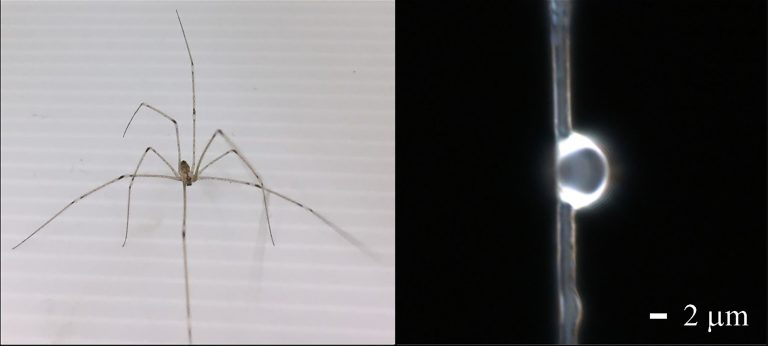Jul 1 2020
Spiders are generally good only for insect control. However, a new study has shown that they are worth more than that.
 An image of the spider used in the study and the dome lens generated on its dragline silk. Image Credit: Cheng-Yang Liu.
An image of the spider used in the study and the dome lens generated on its dragline silk. Image Credit: Cheng-Yang Liu.
Spider silk is valuable for a range of biomedical applications. For tissue engineering, it displays mechanical properties better than synthetic fibers and is not dangerous or toxic to living cells.
One surprising application for spider silk is to develop biocompatible lenses for biological imaging applications. A research team from Tamkang University and National Yang-Ming University in Taiwan explains the possibility of making lenses by leveraging the properties of natural spider silk material in the Journal of Applied Physics, from AIP Publishing.
A spider has the ability to spin various types of silks, each with diverse functions and properties. Spiders make use of a kind of silk called dragline silk to make the spokes of their web.
Dragline silk is an interesting natural material because of its significant features, such as high elasticity, great toughness and large tensile strength.
Cheng-Yang Liu, Study Author and Professor, National Yang-Ming University
When compared to the weight of the dragline silk, its strength is greater than steel.
The researchers gathered smooth, even dragline silk from Pholcus phalangioides spiders, famously called daddy longlegs, and dripped a resin onto the silk fiber. As soon as the resin condensed on the fiber, due to the wetting properties of the silk, it naturally developed it into a dome shape, which could be utilized as an optical lens. The silk’s optical and mechanical properties also make it perfect for supporting the lens.
When the researchers shined a laser onto the lens, it produced a high-quality photonic nanojet—a kind of beam that can offer large-area and super-resolution imaging for biomedical applications.
By adjusting how long the silk stays under the resin drip, the size of the dome lens can be altered, thus enabling the photonic nanojets to be enhanced for the preferred type of imaging.
The dome lens with flexible photonic nanojets is suitable for imaging the nanoscale objectives in different depths within biological tissue.
Cheng-Yang Liu, Study Author and Professor, National Yang-Ming University
Following further testing, the team believes this kind of spider silk-based lens can be utilized to offer light for biological imaging and operation.
Journal Reference:
Lin, C. B., et al. (2020) Optimal photonic nanojet beam shaping by mesoscale dielectric dome lens. Journal of Applied Physics. doi.org/10.1063/5.0007611.